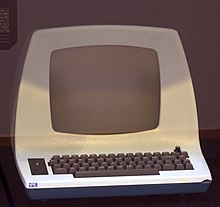ADM-3A
ADM-3A is an ASCII - computer terminal , built by Lear Siegler and from 1976 on the market, one of the first computer terminals. On its 30 cm (12 inch) monochrome screen, it could display 12 or 24 lines of 80 ASCII characters each. It has an extended typewriter keyboard with 59 keys, QWERTY assignment, with some specially assigned keys. It was connected to the host computer via a serial interface , selectable according to the EIA-232 standard or as a 20 mA teletype connection . It was available as a kit for US $ 995 or as a fully assembled device for US $ 1,195.
The original version, the ADM-3 , could only display capital letters. The configuration took place via 32 DIP switches , among other things the data transfer rate could be set between 70 and 19,200 bps. As a special feature, and in contrast to later developed computer terminals such as the VT100 , the ADM-3A does not use a microprocessor . The complete circuit consists of a large number of 74xx logic modules with which the complete video controller and cursor control are implemented. The only higher integrated circuits are the Universal Asynchronous Receiver Transmitter (UART), the RAM memory as text memory and a permanently programmed ROM chip , which contains the glyphs of the ASCII character set.
The early text editor vi was written on an ADM-3A in 1976 by Bill Joy . Since the ADM-3A for cursor control keys , , and used the appropriate commands in vi are also derived from it. HJKL
Individual evidence
- ↑ ADM-3A on old-computers.com, accessed March 27, 2020.
- ↑ ADM-3A maintenance manual. (PDF; 10.5 MB) Retrieved October 12, 2019 .
- ↑ Xah Lee: History of Emacs and vi Keys xahlee.info, accessed March 27, 2020.

